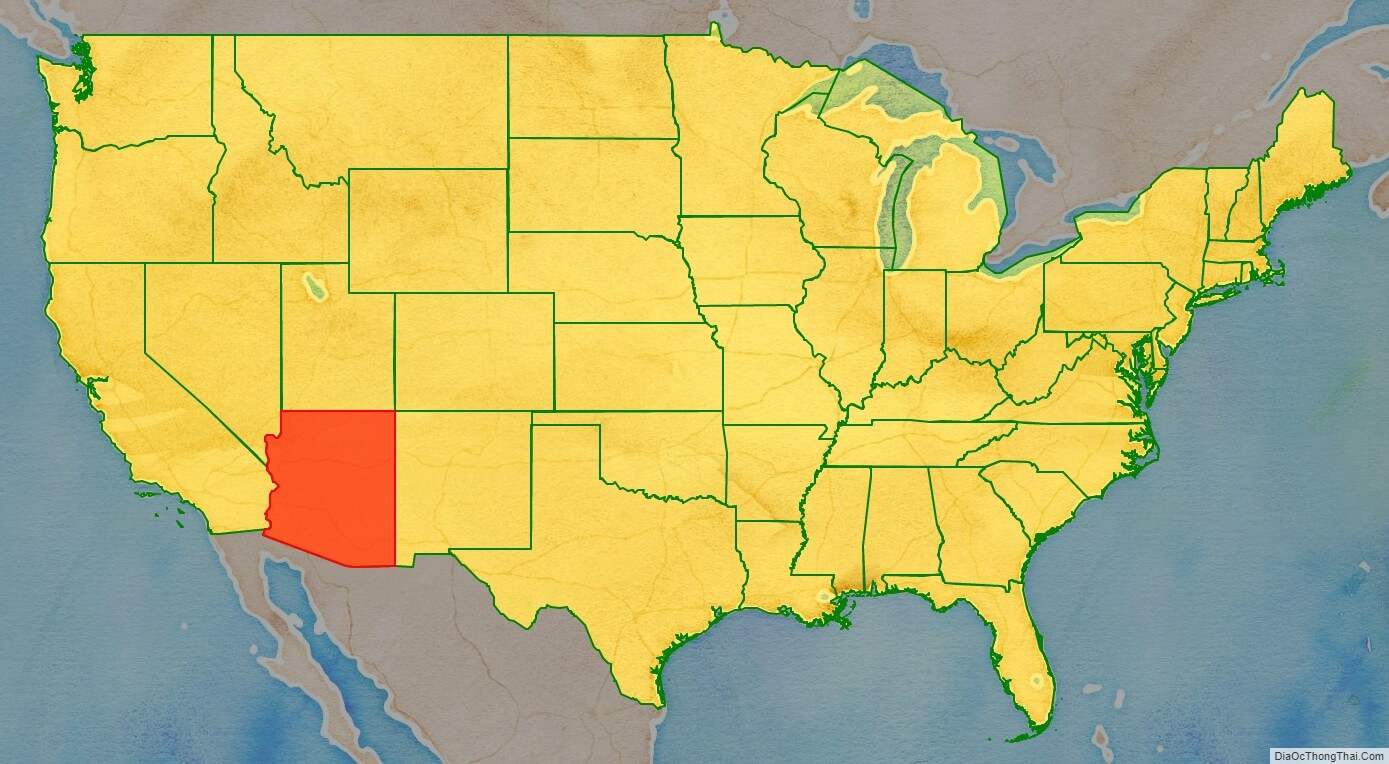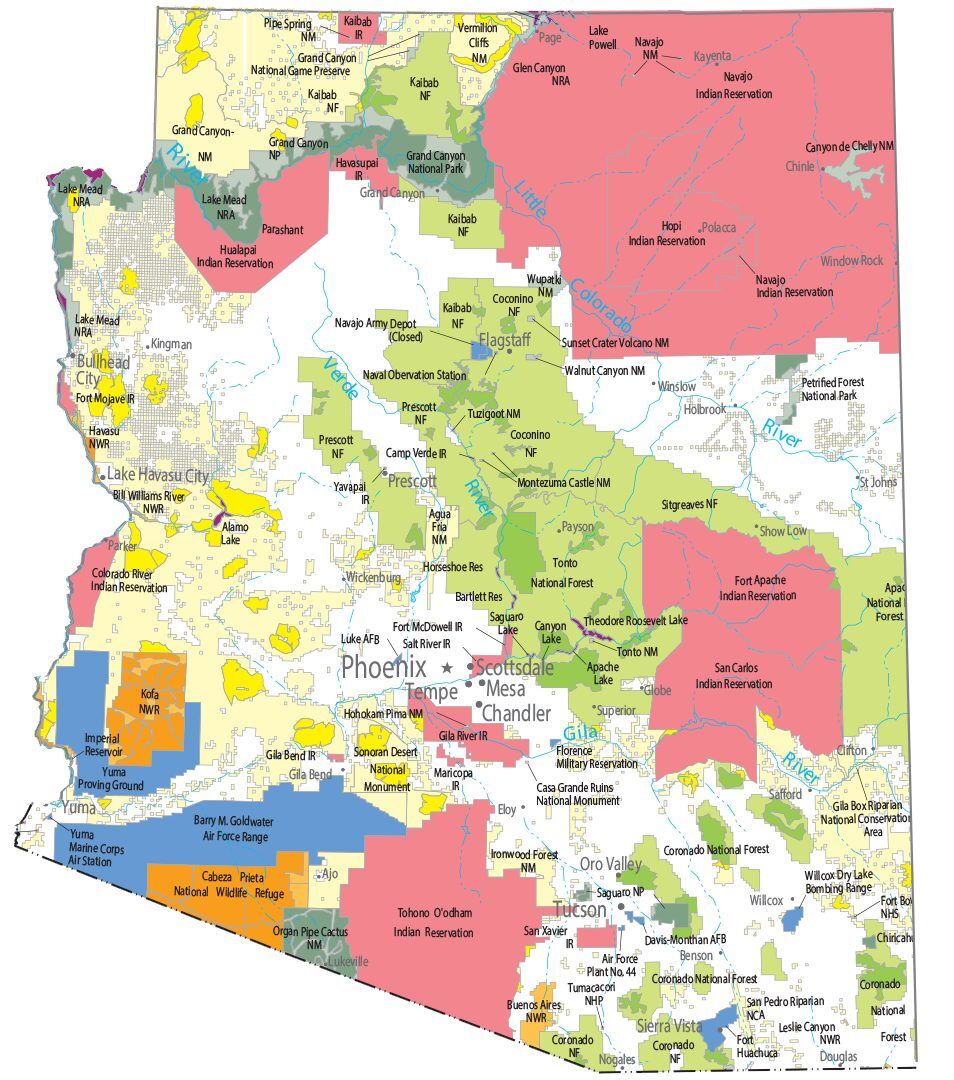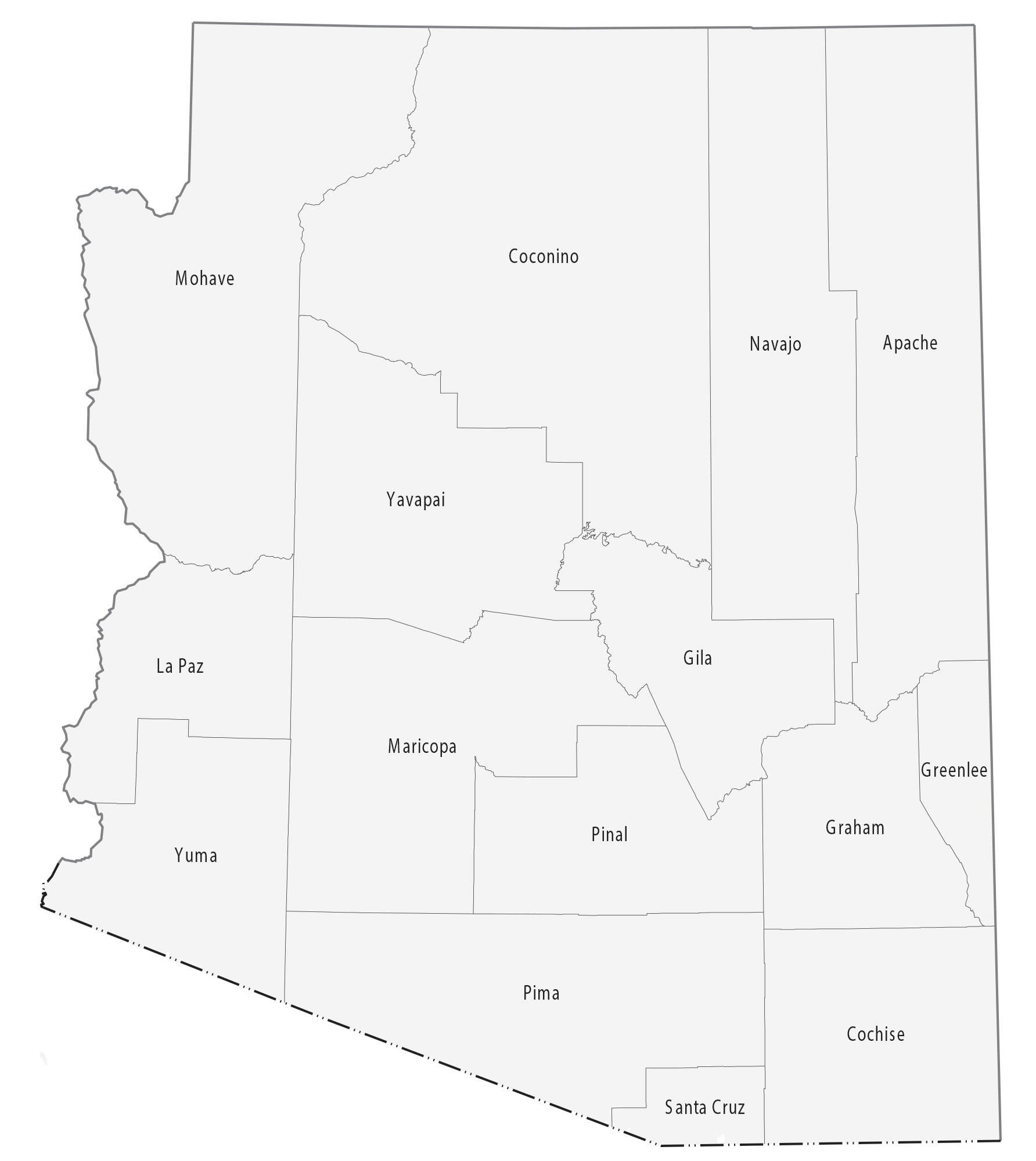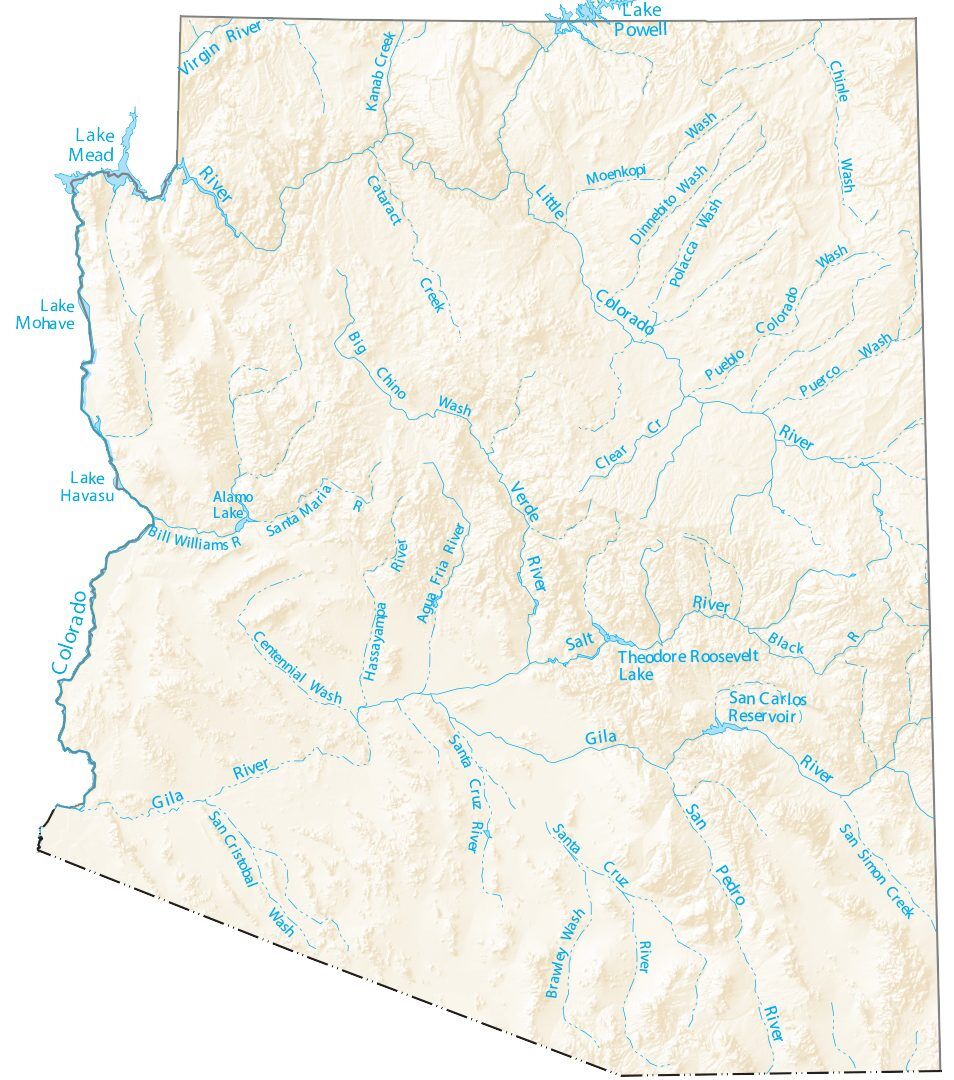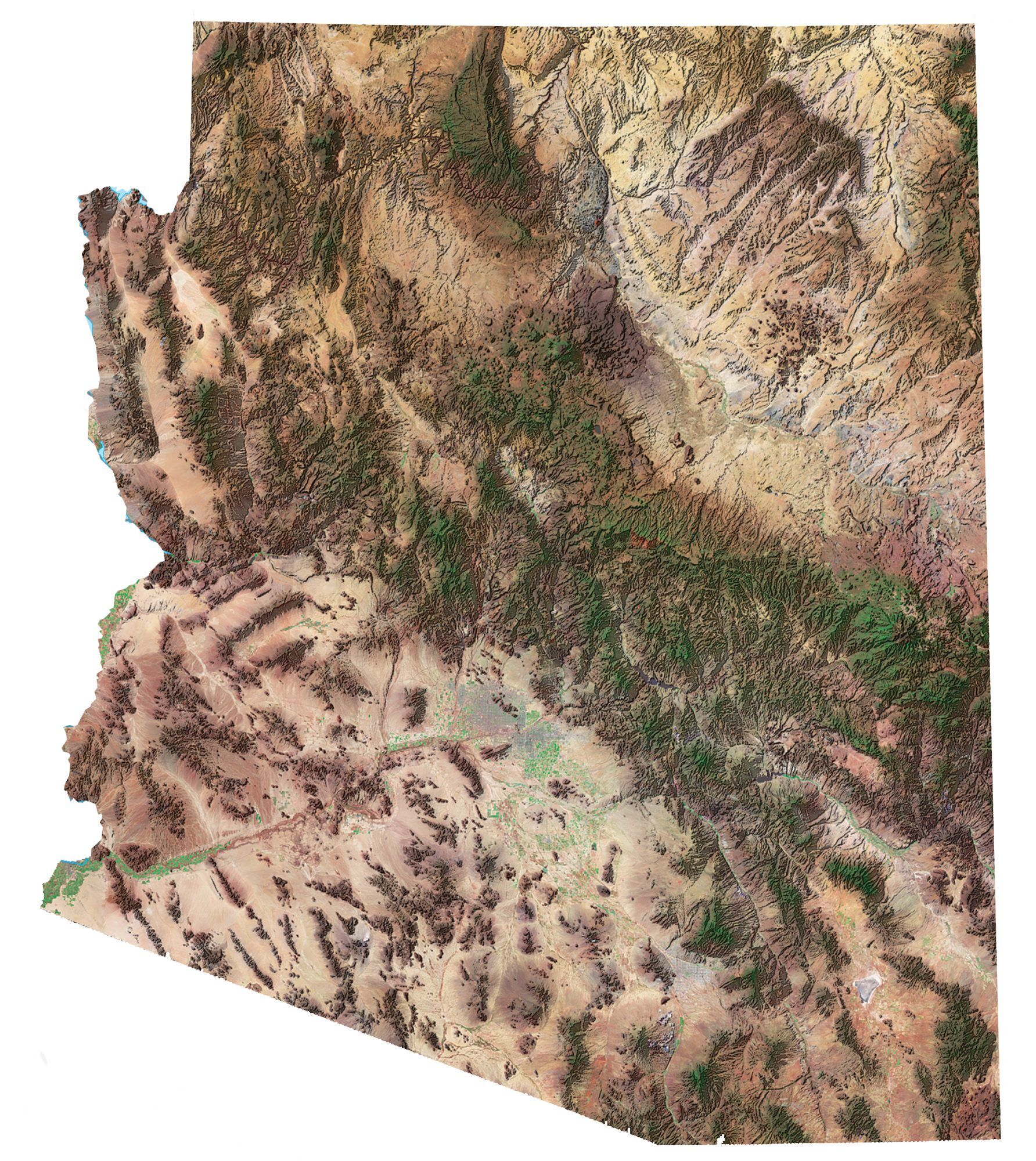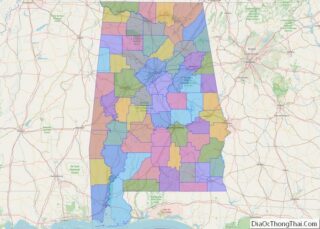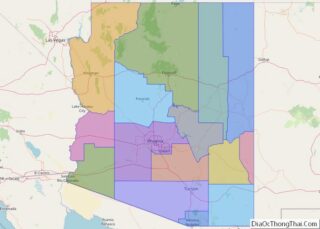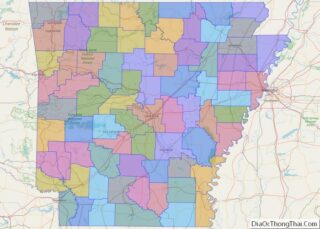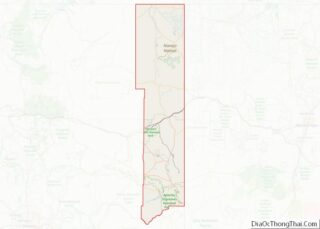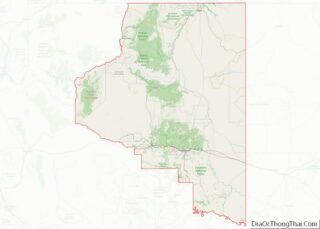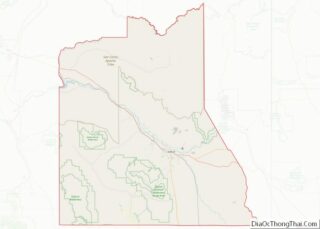Arizona (/ˌærɪˈzoʊnə/ (listen) ARR-ih-ZOH-nə; Navajo: Hoozdo Hahoodzo [hoː˥z̥to˩ ha˩hoː˩tso˩]; O’odham: Alĭ ṣonak [ˈaɭi̥ ˈʂɔnak]) is a state in the Southwestern United States. It is the 6th-largest and the 14th-most-populous of the 50 states. Its capital and largest city is Phoenix. Arizona is part of the Four Corners region with Utah to the north, Colorado to the northeast, and New Mexico to the east; its other neighboring states are Nevada to the northwest, California to the west and the Mexican states of Sonora and Baja California to the south and southwest.
Arizona is the 48th state and last of the contiguous states to be admitted to the Union, achieving statehood on February 14, 1912. Historically part of the territory of Alta California in New Spain, it became part of independent Mexico in 1821. After being defeated in the Mexican–American War, Mexico ceded much of this territory to the United States in 1848. The southernmost portion of the state was acquired in 1853 through the Gadsden Purchase.
Southern Arizona is known for its desert climate, with very hot summers and mild winters. Northern Arizona features forests of pine, Douglas fir, and spruce trees; the Colorado Plateau; mountain ranges (such as the San Francisco Mountains); as well as large, deep canyons, with much more moderate summer temperatures and significant winter snowfalls. There are ski resorts in the areas of Flagstaff, Alpine, and Tucson. In addition to the internationally known Grand Canyon National Park, which is one of the world’s seven natural wonders, there are several national forests, national parks, and national monuments.
Arizona’s population and economy have grown dramatically since the 1950s because of inward migration, and the state is now a major hub of the Sun Belt. Cities such as Phoenix and Tucson have developed large, sprawling suburban areas. Many large companies, such as PetSmart and Circle K, have headquarters in the state, and Arizona is home to major universities, including the University of Arizona and Arizona State University. Traditionally, the state is politically known for national conservative figures such as Barry Goldwater and John McCain, though it voted Democratic in the 1996 presidential race and in the 2020 presidential and senatorial elections.
Arizona is home to a diverse population. About one-quarter of the state is made up of Indian reservations that serve as the home of 27 federally recognized Native American tribes, including the Navajo Nation, the largest in the state and the United States, with more than 300,000 citizens. Since the 1980s, the proportion of Hispanics in the state’s population has grown significantly owing to migration from Mexico. In terms of religion, a substantial portion of the population are followers of the Roman Catholic Church and the Church of Jesus Christ of Latter-day Saints (LDS Church).
| Before statehood: | Arizona Territory |
|---|---|
| Admitted to the Union: | February 14, 1912; 111 years ago (1912-02-14) (48th) |
| Capital: | Phoenix |
| Capital – largest city: | largest city |
| Largest metro and urban areas: | Phoenix |
| Elevation: | 4,100 ft (1,250 m) |
| Total Area: | 113,990 sq mi (295,234 km) |
| Area Rank: | 6th |
| Total Population: | 7,151,502 |
| Population Rank: | 14th |
| Population Density: | 57/sq mi (22/km) |
| Population Density Rank: | 33rd |
| Median Household Income: | $61,500 |
| Income Rank: | 28th |
| Demonym(s): | Arizonan |
| USPS abbreviation: | AZ |
| ISO 3166 code: | US-AZ |
| Website: | az.gov |
Online Interactive Map
Click on ![]() to view map in "full screen" mode.
to view map in "full screen" mode.
Arizona location map. Where is Arizona state?
Arizona Road Map
Arizona Map – Roads & Cities
Arizona Street Map
History
For thousands of years before the modern era, Arizona was home to many ancient Native American civilizations. Hohokam, Mogollon, and Ancestral Puebloan cultures were among those that flourished throughout the state. Many of their pueblos, cliffside dwellings, rock paintings and other prehistoric treasures have survived and attract thousands of tourists each year.
In 1539, Marcos de Niza, a Spanish Franciscan, became the first European to contact Native Americans. He explored parts of the present state and made contact with native inhabitants, probably the Sobaipuri. The expedition of Spanish explorer Coronado entered the area in 1540–1542 during its search for Cíbola. Few Spanish settlers migrated to Arizona. One of the first settlers in Arizona was José Romo de Vivar.
Father Kino was the next European in the region. A member of the Society of Jesus (“Jesuits”), he led the development of a chain of missions in the region. He converted many of the Indians to Christianity in the Pimería Alta (now southern Arizona and northern Sonora) in the 1690s and early 18th century. Spain founded presidios (“fortified towns”) at Tubac in 1752 and Tucson in 1775.
When Mexico achieved its independence from the Kingdom of Spain and its Spanish Empire in 1821, what is now Arizona became part of its Territory of Nueva California, (“New California”), also known as Alta California (“Upper California”). Descendants of ethnic Spanish and mestizo settlers from the colonial years still lived in the area at the time of the arrival of later European-American migrants from the United States.
During the Mexican–American War (1847–1848), the U.S. Army occupied the national capital of Mexico City and pursued its claim to much of northern Mexico, including what later became Arizona Territory in 1863 and later the State of Arizona in 1912. The Treaty of Guadalupe Hidalgo (1848) specified that, in addition to language and cultural rights of the existing inhabitants of former Mexican citizens being considered as inviolable, the sum of $15 million in compensation (equivalent to $469,788,461.54 in 2021) be paid to the Republic of Mexico. In 1853, the U.S. acquired the land south below the Gila River from Mexico in the Gadsden Purchase along the southern border area as encompassing the best future southern route for a transcontinental railway.
What is now the state of Arizona was administered by the United States government as part of the Territory of New Mexico from 1850 until the southern part of that region seceded from the Union to form the Territory of Arizona. This newly established territory was formally organized by the federal government of the Confederate States on Saturday, January 18, 1862, when President Jefferson Davis approved and signed An Act to Organize the Territory of Arizona, marking the first official use of the name “Territory of Arizona”. The Southern territory supplied the Confederate government with men, horses, and equipment. Formed in 1862, Arizona scout companies served with the Confederate States Army during the American Civil War. Arizona has the westernmost military engagement on record during the Civil War with the Battle of Picacho Pass (1862).
The Federal government declared a new U.S. Arizona Territory, consisting of the western half of earlier New Mexico Territory, in Washington, D.C., on February 24, 1863. These new boundaries would later form the basis of the state. The first territorial capital, Prescott, was founded in 1864 following a gold rush to central Arizona. The capital was later moved to Tucson, back to Prescott, and then to its final location in Phoenix in a series of controversial moves as different regions of the territory gained and lost political influence with the growth and development of the territory.
Although names including “Gadsonia”, “Pimeria”, “Montezuma” and “Arizuma” had been considered for the territory, when 16th President Abraham Lincoln signed the final bill, it read “Arizona”, and that name was adopted. (Montezuma was not derived from the Aztec emperor, but was the sacred name of a divine hero to the Pima people of the Gila River Valley. It was probably considered – and rejected – for its sentimental value before Congress settled on the name “Arizona”.)
Brigham Young, patriarchal leader of the Church of Jesus Christ of Latter-day Saints in Salt Lake City in Utah, sent Mormons to Arizona in the mid- to late 19th century. They founded Mesa, Snowflake, Heber, Safford, and other towns. They also settled in the Phoenix Valley (or “Valley of the Sun”), Tempe, Prescott, and other areas. The Mormons settled what became northern Arizona and northern New Mexico. At the time these areas were in a part of the former New Mexico Territory.
During the nineteenth century, a series of gold and silver rushes occurred in the territory, the best known being the 1870s stampede to the silver bonanzas of Tombstone, Arizona in southeast Arizona, also known for its legendary outlaws and lawmen. By the late 1880s, copper production eclipsed the precious metals with the rise of copper camps like Bisbee, Arizona and Jerome, Arizona. The boom and bust economy of mining also left hundreds of ghost towns across the territory, but copper mining continued to prosper with the territory producing more copper than any other state by 1907, which earned Arizona the nickname “the Copper State” at the time of statehood. During the first years of statehood the industry experienced growing pains and labor disputes with the Bisbee Deportation of 1917 the result of a copper miners’ strike.
20th century to present
During the Mexican Revolution from 1910 to 1920, several battles were fought in the Mexican towns just across the border from Arizona settlements. Throughout the revolution, many Arizonans enlisted in one of the several armies fighting in Mexico. Only two significant engagements took place on U.S. soil between U.S. and Mexican forces: Pancho Villa’s 1916 Columbus Raid in New Mexico, and the Battle of Ambos Nogales in 1918 in Arizona. The Mexicans won the first battle and the Americans won the latter.
After Mexican federal troops fired on U.S. soldiers, the American garrison launched an assault into Nogales, Mexico. The Mexicans eventually surrendered after both sides sustained heavy casualties. A few months earlier, just west of Nogales, an Indian War battle had occurred, considered the last engagement in the American Indian Wars, which lasted from 1775 to 1918. U.S. soldiers stationed on the border confronted Yaqui Indians who were using Arizona as a base to raid the nearby Mexican settlements, as part of their wars against Mexico.
Arizona became a U.S. state on February 14, 1912. Arizona was the 48th state admitted to the U.S. and the last of the contiguous states to be admitted.
Cotton farming and copper mining, two of Arizona’s most important statewide industries, suffered heavily during the Great Depression. But during the 1920s and even the 1930s, tourism began to develop as the important Arizonan industry it is today. Dude ranches, such as the K L Bar and Remuda in Wickenburg, along with the Flying V and Tanque Verde in Tucson, gave tourists the chance to take part in the flavor and activities of the “Old West”. Several upscale hotels and resorts opened during this period, some of which are still top tourist draws. They include the Arizona Biltmore Hotel in central Phoenix (opened 1929) and the Wigwam Resort on the west side of the Phoenix area (opened 1936).
Arizona was the site of German prisoner of war camps during World War II and Japanese American internment camps. Because of wartime fears of a Japanese invasion of the U.S. West Coast (which in fact materialized in the Aleutian Islands Campaign in June 1942). From 1942 to 1945, they were forced to reside in internment camps built in the interior of the country. Many lost their homes and businesses. The camps were abolished after World War II.
The Phoenix-area German P.O.W. site was purchased after the war by the Maytag family (of major home appliance fame). It was developed as the site of the Phoenix Zoo. A Japanese-American internment camp was on Mount Lemmon, just outside the state’s southeastern city of Tucson. Another POW camp was near the Gila River in eastern Yuma County. Arizona was also home to the Phoenix Indian School, one of several federal Indian boarding schools designed to assimilate Native American children into mainstream European-American culture. Children were often enrolled in these schools against the wishes of their parents and families. Attempts to suppress native identities included forcing the children to cut their hair, to take and use English names, to speak only English, and to practice Christianity rather than their native religions.
Numerous Native Americans from Arizona fought for the United States during World War II. Their experiences resulted in a rising activism in the postwar years to achieve better treatment and civil rights after their return to the state. After Maricopa County did not allow them to register to vote, in 1948 veteran Frank Harrison and Harry Austin, of the Mojave-Apache Tribe at Fort McDowell Indian Reservation, brought a legal suit, Harrison and Austin v. Laveen, to challenge this exclusion. The Arizona Supreme Court ruled in their favor.
Arizona’s population grew tremendously with residential and business development after World War II, aided by the widespread use of air conditioning, which made the intensely hot summers more comfortable. According to the Arizona Blue Book (published by the Arizona Secretary of State’s office each year), the state population in 1910 was 294,353. By 1970, it was 1,752,122. The percentage growth each decade averaged about 20% in the earlier decades, and about 60% each decade thereafter.
In the 1960s, retirement communities were developed. These age-restricted subdivisions catered exclusively to the needs of senior citizens and attracted many retirees who wanted to escape the harsh winters of the Midwest and the Northeast. Sun City, established by developer Del Webb and opened in 1960, was one of the first such communities. Green Valley, south of Tucson, was another such community, designed as a retirement subdivision for Arizona’s teachers. Many senior citizens from across the U.S. and Canada come to Arizona each winter and stay only during the winter months; they are referred to as snowbirds.
In March 2000, Arizona was the site of the first legally binding election ever held over the internet to nominate a candidate for public office. In the 2000 Arizona Democratic Primary, under worldwide attention, Al Gore defeated Bill Bradley. Voter turnout in this state primary increased more than 500% over the 1996 primary.
In the 21st century, Arizona has frequently garnered national attention for its efforts to quell illegal immigration into the state. In 2004, voters passed Proposition 200, requiring proof of citizenship to register to vote. The Supreme Court of the United States struck this restriction down in 2013. In 2010, Arizona enacted SB 1070 which required all immigrants to carry immigration papers at all times, but the Supreme Court also invalidated parts of this law in Arizona v. United States in 2012.
On January 8, 2011, a gunman shot congresswoman Gabby Giffords and 18 others at a gathering in Tucson. Giffords was critically wounded. The incident sparked national attention regarding incendiary political rhetoric.
Three ships named USS Arizona have been christened in honor of the state, although only USS Arizona (BB-39) was so named after statehood was achieved.
Arizona State Map – Places and Landmarks
Arizona Political Map

Arizona Lakes and Rivers Map
Geography
Arizona is in the Southwestern United States as one of the Four Corners states. Arizona is the sixth largest state by area, ranked after New Mexico and before Nevada. Of the state’s 113,998 square miles (295,000 km), approximately 15% is privately owned. The remaining area is public forest and parkland, state trust land and Native American reservations. There are 24 National Park Service maintained sites in Arizona, including the three national parks of Grand Canyon National Park, Saguaro National Park, and the Petrified Forest National Park.
Arizona is well known for its desert Basin and Range region in the state’s southern portions, which is rich in a landscape of xerophyte plants such as the cactus. This region’s topography was shaped by prehistoric volcanism, followed by the cooling-off and related subsidence. Its climate has exceptionally hot summers and mild winters. The state is less well known for its pine-covered north-central portion of the high country of the Colorado Plateau (see Arizona Mountains forests).
Like other states of the Southwest United States, Arizona is marked by high mountains, the Colorado plateau, and mesas. Despite the state’s aridity, 27% of Arizona is forest, a percentage comparable to modern-day Romania or Greece. The world’s largest stand of ponderosa pine trees is in Arizona.
The Mogollon Rim (/ ˌmoʊ gəˈyoʊn /), a 1,998-foot (609 m) escarpment, cuts across the state’s central section and marks the southwestern edge of the Colorado Plateau. In 2002, this was an area of the Rodeo–Chediski Fire, the worst fire in state history until 2011.
Located in northern Arizona, the Grand Canyon is a colorful, deep, steep-sided gorge, carved by the Colorado River. The canyon is one of the Seven Natural Wonders of the World and is largely contained in the Grand Canyon National Park – one of the first national parks in the United States. President Theodore Roosevelt was a major proponent of designating the Grand Canyon area as a National Park, often visiting to hunt mountain lion and enjoy the scenery. The canyon was created by the Colorado River cutting a channel over millions of years, and is about 277 miles (446 km) long, ranges in width from 4 to 18 miles (6 to 29 km) and attains a depth of more than 1 mile (1.6 km). Nearly two billion years of the Earth’s history have been exposed as the Colorado River and its tributaries cut through layer after layer of sediment as the Colorado Plateau uplifted.
Arizona is home to one of the most well-preserved meteorite impact sites in the world. Created around 50,000 years ago, the Barringer Meteorite Crater (better known simply as “Meteor Crater”) is a gigantic hole in the middle of the high plains of the Colorado Plateau, about 25 miles (40 km) west of Winslow. A rim of smashed and jumbled boulders, some of them the size of small houses, rises 150 feet (46 m) above the level of the surrounding plain. The crater itself is nearly a mile (1.6 kilometers) wide and 570 feet (170 m) deep.
Arizona is one of two U.S. states, along with Hawaii, that does not observe Daylight Saving Time, though the large Navajo Nation in the state’s northeastern region does.
Adjacent states
- Utah (north)
- Colorado (northeast)
- Nevada (northwest)
- Sonora, Mexico (south)
- Baja California, Mexico (southwest)
- New Mexico (east)
- California (west)
Arizona Physical Map
Arizona Topographic Map
Arizona Satellite Map
Others printable maps
Arizona Outline Map
Blank Arizona County Map
See also
Map of Arizona State and its subdivision: Map of other states:- Alabama
- Alaska
- Arizona
- Arkansas
- California
- Colorado
- Connecticut
- Delaware
- District of Columbia
- Florida
- Georgia
- Hawaii
- Idaho
- Illinois
- Indiana
- Iowa
- Kansas
- Kentucky
- Louisiana
- Maine
- Maryland
- Massachusetts
- Michigan
- Minnesota
- Mississippi
- Missouri
- Montana
- Nebraska
- Nevada
- New Hampshire
- New Jersey
- New Mexico
- New York
- North Carolina
- North Dakota
- Ohio
- Oklahoma
- Oregon
- Pennsylvania
- Rhode Island
- South Carolina
- South Dakota
- Tennessee
- Texas
- Utah
- Vermont
- Virginia
- Washington
- West Virginia
- Wisconsin
- Wyoming
